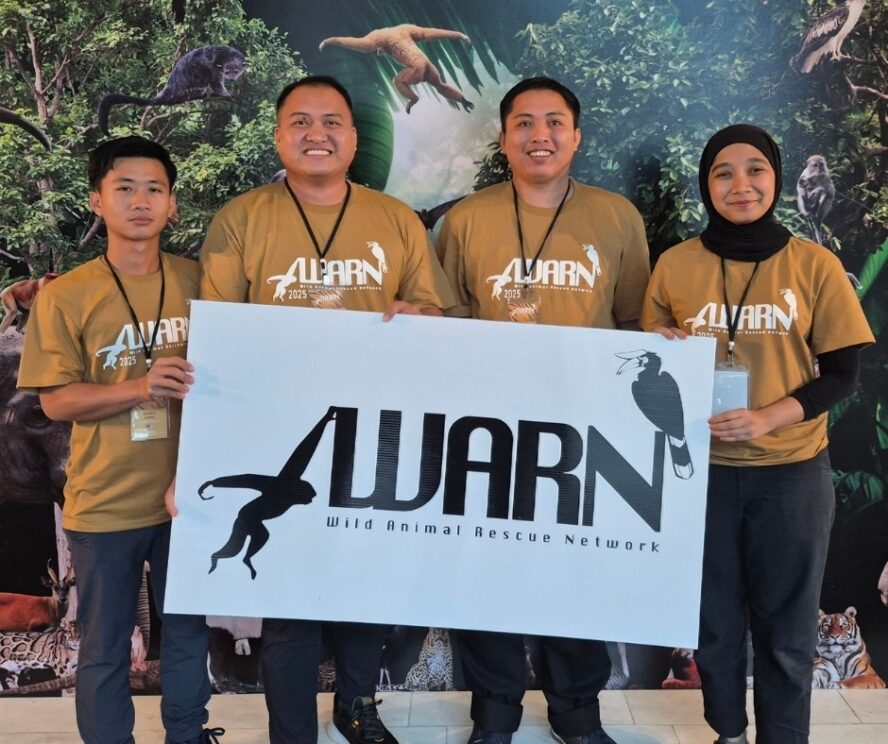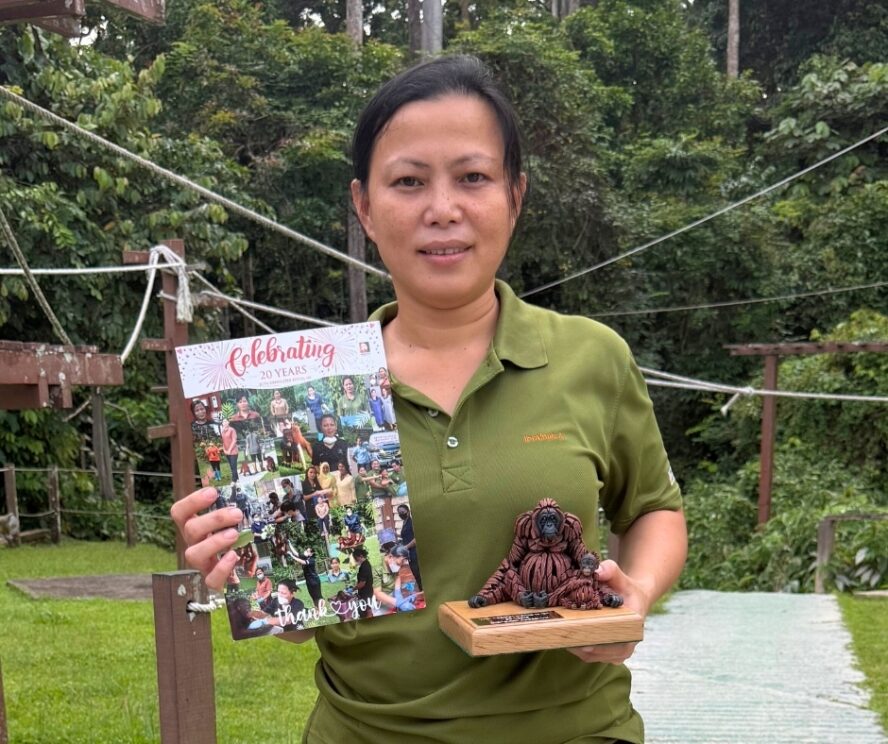News
Orangutan Appeal UK and OuTrop join forces
As an OuTrop conservation partner, Orangutan Appeal UK have supported the Community Patrol Team's fire-fighting efforts for the last few years.
29/07/2015
Funding drone technology
As an OuTrop conservation partner, Orangutan Appeal UK have supported the Community Patrol Team's fire-fighting efforts for the last few years and in 2015 funded the purchase of exciting new drone technology to support these fire-fighting efforts.
Orangutan Appeal UK have given a grant of £6,277 to fully cover the cost of all the drone technology.
The Orangutan Tropical Peatland Project (OuTrop) works to protect large forested landscapes in Central Kalimantan, which contain several of the most important remaining populations of the Bornean orangutan. We do this through programmes of habitat conservation, forest restoration, community engagement and research, with our main aim being to protect wild orangutans in-situ in their natural environment.

Our primary focus site is the Sabangau Forest, which is the largest intact peat-swamp forest and contiguous block of lowland rainforest remaining on Borneo, and as such contains the world’s largest orangutan population. Orangutans are Sabangau’s flagship species for all our work to protect this fragile habitat and its wonderful biodiversity. Sabangau is home to many endangered species of plant and animal; provides clean water, air, fish stocks, non-timber forest products and many other natural-resource functions that benefit the surrounding communities; and is a major global store of terrestrial carbon, with a thick peat layer up to 15 m deep that stores 90% of the forest’s biomass.
OuTrop was founded in 1999 to help protect this forest and its critical orangutan population from illegal logging and fire, focusing on research to raise awareness about Sabangau’s importance, and working in partnership with local conservationists and scientists at the University of Palangka Raya. These efforts led to designation of the 578,000 ha Sebangau National Park in 2004, to complement the 50,000 ha Natural Laboratory of Peat-swamp Forest (NLPSF), a research area integral to the Sabangau Forest that is managed by the Centre for International Cooperation for Sustainable Management of Tropical Peatland (CIMTROP). Despite this, Sabangau remains at risk because of high local demand for timber, animals and other forest products; clearing and development of adjacent land; and in particular from fire owing to the long-term consequences of past illegal logging. Illegal loggers dug narrow channels in the peat to float out felled timber, and larger canals were dug in some areas to drain the peatland for proposed agricultural projects. These channels remain long after the immediate logging problem has gone, draining the once water-logged peat. This is an incredibly serious conservation problem, as it causes the peat to dry out and oxidise, putting the whole ecosystem at risk.
Dried peat is highly flammable and fires frequently break out in the forest margins and the surrounding sedge swamp, sometimes burning large areas. Huge areas of drained peatland in Kalimantan have been laid waste by fires over the past 15 years, representing a global ecological disaster. Our active restoration work in Sabangau includes filling-in drainage channels to restore natural hydrology, and replanting burnt and degraded areas of forest. Peat fires occur annually and are the single biggest risk to the Sabangau Forest. Fires arise every dry season and are often the result of land-clearing by burning in neighbouring farms, or fishermen starting small fires on river banks. During El Niño events dry seasons are longer and more severe, and small fires can quickly grow and get out of hand. With support from OAUK, the local CIMTROP Community Patrol Team have been working to patrol the forest in NLPSF and its waterways for fire, and extinguish any fires that do emerge. This work was particularly important in late 2014, when dry conditions led to high fire risk and incidence in the area. This work is currently hampered by difficulties in detecting and monitoring fires over the large landscape, and in assessing the constantly-evolving extent of fires in active hotspot areas.
The large size and difficulty of access of the NLPSF, plus difficulty in obtaining good visuals from the ground to assess fires, makes these critical tasks both difficult and dangerous for on-the-ground fire-fighting teams. To overcome these obstacles, we propose the use of conservation drones to assess and monitor fire from the air. 2 Current Conservation Drone Use At the end of 2014 we purchased a Quadcopter Drone, equipped with a small Go Pro camera. This new technology will be applied for many conservation purposes, including assessing and monitoring peat fires. The drone will initially be used to optimise manpower effort for the following purposes: i. Mapping and monitoring burn areas and forest borders. ii. Spotting and monitoring fires during the dry season. iii. Monitoring disturbed habitat succession and regeneration. iv. Producing images and videos for OuTrop communication, awareness and education purposes. v. Involving and engaging the local community in conservation efforts as part of our holistic approach towards conservation and local capacity building. The primary purpose is to apply this technology to fire spotting, by identifying burning areas from afar and surveying live fires, with the aim to tackle fires more quickly, efficiently and safely.
To date, our priority has been training members of the Community Patrol Team and start using it during the expected 2015 fire season, which may be particularly severe if El Niño persists as forecast (NOAA currently consider there to be an 85% chance that El Niño conditions will continue through autumn and into winter 2015). We have started these training sessions to teach team members about (i) drone safety and handling and (ii) mapping techniques, camera settings and software use. We mapped the NLPSF research camp from the sky using the photocomposition software (see photo on next page and video on our Facebook page). We aim to use this technique for live studying of active fires and to measure the extent of previously burned areas in Sabangau, but limitations in our current drone equipment will restrict our ability to do this over large areas. The Community Patrol Team, are now becoming proficient in drone handling and flying, and will use it during the upcoming fire fighting season to spot and tackle fires. This will optimize patrolling activities, plus reduce costs and risks faced by team members, by assessing the fire condition before tackling it and enabling fire tracking fire-fighting is underway. No dedicated grant support has been received to cover the costs of this drone equipment.
OuTrop’s Field Director, Bernat Ripoll Capilla, running a drone training session with two members of the local CIMTROP Community Patrol Team. 3 High-quality aerial photocomposition of the Natural Laboratory Basecamp, with the drone flying team visible in the badminton court at the bottom. Proposed Conservation Drone Use Expansion: 2015-16 Our current quadcopter conservation drone (DJI Phantom 2) is able to take off and land “on the spot”, can be flown using remote control up to 400 m from the pilot on the ground, can automatically return “home” in case of loss of signal or battery power, and can obtain high-quality visuals. It therefore offers high utility for spotting smoke columns, is useful when take-off/landing sites are small, and is good for high-resolution mapping and monitoring over relatively small areas. The visuals produced are of high quality and are a very effective tool for easily communicating, increasing understanding and raising awareness of fire-related issues to local and international conservation stakeholders. While of great benefit, this current drone equipment does suffer from a number of deficiencies, which are limiting its potential use and conservation impacts. Firstly, the drone does not provide geo-referenced images and cannot be pre-programmed to fly specific routes.
All flights are therefore controlled by remote control as they happen by the pilot on the ground (allowing drones to fly 4 “blindfolded” out of sight is unacceptably risky). This, plus the drone’s limited battery life and quadcopter design, mean that it is unable to fly large distances away from the take-off location. The drone therefore cannot fly out of the sight of the pilot or fly when visibility is poor, such as in very smoky conditions during peat fires. To address these deficiencies and realise the true potential of conservation drones in supporting our fire-fighting efforts, we propose the following additions to our drone equipment. Purchase of a Ground Station and 2/3D Software to Enhance Existing Quadcopter Drone Utility In order to pre-programme the drone to fly a specified route, purchase of a ground station is necessary. This tool enables the drone to fly pre-defined geo-referenced routes and provide georeferenced images/visuals. With a ground station, the pilot can pre-programme flight heights and speeds, plus route waypoints, allowing safe and highly-accurate flight over routes that extend beyond visual range (BVR) of the pilot on the ground.
Potential applications of this include flying around the periphery of active fire hotspots to provide real-time monitoring of fire spread and containment, even in smoky conditions when visibility is restricted for a ground-based pilot. It will also enable us to regularly repeat the same routes for monitoring purposes; e.g., monitoring the same specific burned area every year to assess habitat succession, or regular flight patrols alongside rivers where human traffic and therefore fire ignition risk is highest.
The ground station’s photogrammetry tool further facilitates accurate and professional mapping, including both 2D and 3D analysis. These additional capabilities will greatly enhance the potential for this existing drone for small-scale fire mapping and monitoring, plus habitat succession/regeneration research purposes. Purchase of a New Plane Drone for Mapping and Monitoring over Large Areas Battery limitations within the more power-guzzling quadcopter drones mean that they are unable to fly for more than 10-15 minutes without requiring a battery recharge. They therefore cannot cover areas greater than around 5 ha, and are consequently unsuitable for larger-scale fire mapping and monitoring purposes. In contrast, the fixed-wing structure and more light-weight frame of plane drones makes their flight more energy efficient, enabling them to fly longer distances between each battery recharge.
The proposed plane drone is able to fly for up to 40 minutes, covering an area of up to 100 ha without requiring recharging batteries. Pix4Dmapper flight programming software is included within the drone package, to enable automated BVR flying. This would allow the drone to patrol and map much more of the highest-risk areas in the NLPSF from a take-off location in the neighbouring village of Kereng Bangkirai, thereby substantially enhancing our fire monitoring ability. As with the quadcopter drone, photos taken during flights are geo-referenced to enable accurate mapping, and post-processing software enables photos to be stitched into high-resolution maps covering larger areas (cf. the photo of camp provided on the previous page).
The combination of the proposed enhancements to the existing quadcopter drone, the 2/3D mapping software and this new plane drone will provide the suite of tools needed to maximise the potential of drones in supporting fire-fighting in Sabangau. The disadvantage of the quadcopter drone in its limited coverage area will be addressed by the plane drone’s greater flight time, and ability to efficiently assess, map and monitor fire over larger areas. This will enhance fire detection capacity, thus enabling more rapid and efficient deployment of fire-fighting teams. Conversely, while the plane drone requires a landing strip for take-off and landing, the quadcopter drone can take off and land vertically from a very restricted area.
This makes it more suitable for deployment from (often remote) active fire zones for real-time monitoring of fire spread and containment during fire fighting. It is also superior for small-scale, high-resolution habitat mapping purposes. These large- 5 scale habitat mapping data also will complement our current primate research, forestry monitoring and conservation projects in remote areas where mapping data are not currently available or are deficient. Monitoring and Assessment The effectiveness of these drone equipment additions will be assessed during and reported following the 2015 fire season, which will help inform future drone equipment developments.
If deemed necessary following these assessments, this may include future purchase of heat-sensors. These sensors are expensive, but could potentially detect fire burning under the peat in very smoky conditions and are designed to be fitted to the drones described above. Reports, photos and maps produced using the drones will be combined with fire reports from the on-the-ground fire-fighting team, and shared with local conservation managers and authorities, plus funders and the wider international conservation community. N.B. The drones proposed above will not replace regular on-the-ground fire patrols, which will remain essential for on-the-ground verification and assessment; maintaining visible team presence in the area to prevent people starting fires, logging and hunting; monitor and repair dams that have been built to help prevent fire; and conduct other on-the-ground patrol activities.
Explore more articles
![WARN Asia Conference Sepilok Team Photo]()
News
WARN Asia Conference 2025
Team travels to Thailand to share expertise and see frontline wildlife rescue in action.
![Ibri celebrating 20 years with Orangutan Appeal UK 1]()
News
Honouring 20 years of incredible service
Ibri celebrates two decades of exceptional care at Sepilok.
![UPM Forum Website Image]()
News
Inspiring next generation of wildlife vets
Online forum for aspiring conservation veterinarians.


